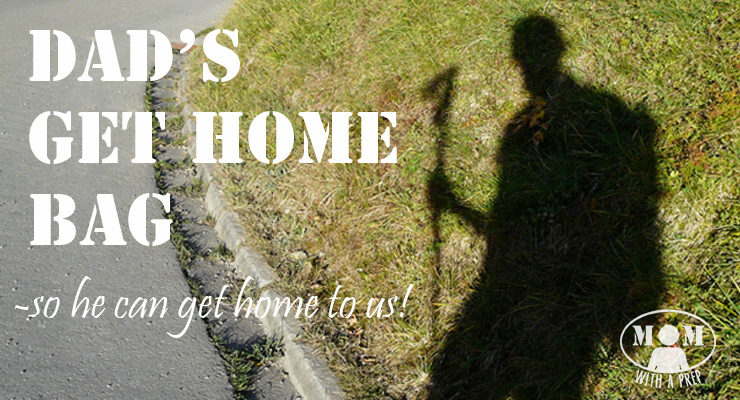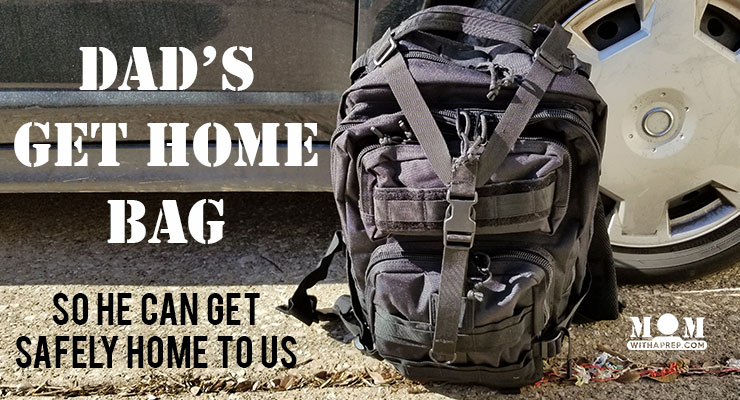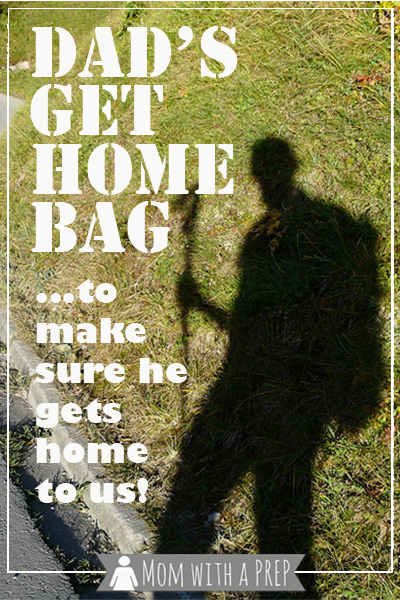If you work and travel within a few walking hours of home, consider a get-home bag instead of hauling a massive survival bag in the back of your car. With a get-home bag, there’s not quite as much to pack, it’s convenient to carry, and it makes traveling back home to your family fast! You’ll never know what will happen along the way. We have to be ready anytime since we are way out of our comfort zone. In cases of emergency, it will be handy to prepare. These necessities will play their roles when danger comes. It’s better to be ready!

Why Would You Need a Get-Home Bag List?
Having a basic get-home bag list is essential to your survival at work or in an unfamiliar place. Have you ever been to a place with limited water and food? If so, it was probably a stressful situation for you.
However, an urban get-home bag list provides all the essentials you need in the event of a terrorist attack, earthquake, tornado, or just getting lost in a new place on your own. In such events, you’ll need protection in the form of shelter, hygiene items, and helpful gear to aid your survival.
What to Include in Your Get Home Bag?
A get-home bag checklist is important to ensure you have all the essentials you need. Take some comfortable shoes with you. A pair of sneakers is a good choice. Although you’ll need to make sure they’re sturdy enough to last hours of wear.
Also, a mylar blanket is lightweight, cheap, and will keep you warm in cold conditions. Most people carry a cell phone with them on their daily errands. But, if you don’t have a spare charger or power source to charge it, there’s little use for it. Instead, we suggest carrying a spare cell phone in your bag to contact authorities (if necessary), or for communicating with your family.
Ensure you have food and drink which will provide you with energy for at least two days, as well as spare money in case you come across a store.
Finally, keep personal hygiene items in your bag for personal comfort. Baby wipes and tissues are some ideal hygiene items to keep yourself clean.
How Much Food and Water Should Be Stored?
The most obvious point to make is that you can’t carry heaps of gear around with you, as you’ll potentially be carrying this bag around for long periods of time. To aid your survival, we recommend enough food and water to last three days.
Usually, within this time, you’ll either be rescued or your absence will at least have been reported to the officials. Remember, a get-home bag isn’t the same as a survival bag, but it’s something that gets you home safely and healthily. Should you find that transportation at your work has been cut off, you’ll need adequate supplies to stay safe.
We recommend two liters of water over this period of time to offer good hydration. Water purification is essential for maintaining a healthy standard of water and limiting chemicals that can enter without a water filter. Without a water filter, the water won’t be as clean. You can also store purification tablets too, as these safely dissolve chemicals and bacteria found in water.
Dad’s Get-Home Bag Story
My husband works about 15 miles away from home. In the event of a regional or national disaster, he might not be home in 30 minutes as his normal routine usually has it. And if that regional disaster meant that no transportation was working, he’d have to walk back home. 15 miles is a long walk – especially if you’re not prepared with a get-home bag.
A get-home bag (read more about emergency bags) is like a survival kit box specially packed to get you home. Unlike a bug-out bag that lasts for days and maybe months, the get-home bag has a survival kit inside to help you survive for a day or two. The bag will get him home from work, assuming a very conservative 6-8 hour hike.
Learn to create your own 72-hour kit for more extended emergencies or evacuations
While he should be able to get home at that time, we do plan for variables and pack personal hygiene items and extra food and water. This bag stays in his car at all times. His car is in an open parking lot, and he keeps this emergency kit inside should he ever forget it one day. He has a small kit in his office under his desk as an extra survival kit at work, too (you can read more about one here).
If he’s traveling farther for some reason, he grabs his BOB (bug-out bag) to throw in there, as well. He also has a small car kit, so he’s got all the essential gear he needs.
Get Home Bag Inspiration Tutorial
When we first began preparing, all the different designations of each bag confused us and made us feel like we were doing bag-on-bag on a bag of the same stuff. Then I saw this video on Youtube by Sensible Prepper (Sootch) and so much made sense, and we were able to begin creating bags for their purpose.
While Sootch’s bag is a great idea, the type of bag you use also will make a difference in regards to the amount of gear you pack, lending itself to different organizational ideas based on its structure. The following is a rundown of my husband’s new Get Home Bag.
Dad’s Get-Home Bag List
See what you need to pull this thing together.
This is what he carries inside it at all times. You’ll see a few of these items duplicated in the bag for extra safety precautions:
- Knife – choose a versatile one that can cut and chop man-made materials;
- Flashlight – don’t settle for a cheap brand, and make sure you have batteries;
No products found.
- Multitool – this versatile tool is the perfect size to keep in your backpack;
- Lighter – don’t go without fire or ever be alone in the dark;
- Phone – make communication with your family if your current cell phone runs out of battery or has no service;
- Pistol – for emergency uses only. Keep in an appropriate case for optimum safety;
- MP3 player – while this might be considered a security issue for some, for DH, it is a big comfort for a long walk home, or in case there are limited people around;
- Various other geeky things that are personal and unique to him – gotta love him.
The Get-Home Bag
This is a nondescript black backpack. We keep many of the small items in little bags we’ve found along the way. This keeps them from getting lost at the bottom of the get-home bag. It has a few straps so we can hook things or tie things to it.
One day, we’ll upgrade to a better-designed hiking backpack. But we certainly don’t want our pack to scream, “HEY! This dude is ready, and he’s got the stuff you want!” Your survival kit should be moderately muted so other people don’t ask for your gear.

UPDATE: We have upgraded his backpack to the one above. We found that with normal wear and tear in the car, that small, nondescript backpack wore out after a while, so I upgraded him.
Want to get a peek at my EDC (Everyday Carry Items)?
Organization of the Bag
We initially took Sensible Prepper’s Zone idea and built our bag with Zone 1 to start, and expanded as we could to create a full bag for my husband. We’ve packed close to this need as well so that the things that are the most essential for survival are the easiest to grab.
However, my husband has worked with it for a while and reorganized it to fit this model for him. So, he thinks this way makes more sense to know where to quickly grab the item he needs. Also, it’s something you’ll want to play with a few times to find the best model for your own needs. If your emergency kit makes it hard to locate things you need, you’re in trouble.
Zone 1 – Quick Safety
- Flashlight – this small, portable flashlight is in his bag at all times, but he also has a larger one in his car;
No products found.
- Headlamp – he wants to be hands-free if he’s walking at dusk or in the dark. His hands can then be carrying other tools that are necessary, and still available to defend himself. He chose this one for himself.
No products found.
- Bucket hat – this is a collapsible hat that will cover more of his neck to keep him warm during a long walk and to keep more of the sun off of him.
- Bandanas – one for draping across the back of his neck to tuck under the hat, the other for use as a sweat rag/dust mask if needed;
- N95 Mask – two options to protect his face against dust and debris.
Get-home Bag Zone 2 – Defensive Gear
- Gun Cleaning Kit – easy to carry around and handy accessories to keep your gun clean;
- Ammo – bring spares if you need to use your gun;
- Extra magazine – an extra magazine for your gun.
Zone 3 – Tools
- Knives – utility knife, combat knife, and folding serrated knife;
- Rain Poncho – you could easily use a trash bag to shelter from the rain, but we’ve opted to go with a full rain poncho to cover man + pack if need be.
- Binoculars (or a monocular) – So, this helps you to see ahead to avoid potentially dangerous things you’ll cross in your path (large crowds, etc.)
- Trash Bags – kept for ground cover or shelter.
- Cash – small denominations and coins.
- Paracord – he keeps a short length of paracord tied to the outside
- Extra batteries – this is just for his flashlights. He carries the same flashlight in his EDC that he has in his get-home bag so that he doesn’t have to pack multiple kinds.
- Map – while he knows his route if he’s relatively close to home, if he happens to travel to a part of the area he doesn’t know well, the map will come in handy.
- Compass – for the same purposes as above.
- Eating Utensil – probably never needed, but it’s one of the very first kit items we bought years ago, and he loves keeping it handy.
- Zip Ties – tie them around your shoes to help your feet grip the floor in icy conditions.
- Duct Tape – repair any ripped clothing and use it as a bandage for injuries.
- Striker fire starter and waterproof matches and lighter – get a fire started for heat and light if necessary.
- Road Flares – attract attention if you’re alone in the dark.
- Chemical Light Sticks – a short-term light source if your lighter runs out.
- A CUT ABOVE THE REST: Compact, agile and ready to face any adventure head-on. Our range of Swiss Army Knives have been...
- DURABLE CONSTRUCTION: Swiss made stainless steel construction encased in our popular scales offers a slimmer profile and...
- COMPACT CARRY: Bring this knife with you on your daily adventures without sacrificing space. It makes a great gift for...
- Heavy duty and double thick, Gorilla Tape offers over-the top results; It's like duct tape on steroids
- Great for indoor or outdoor use and made to stick to Rough, uneven, unforgiving surfaces like wood, stone, stucco,...
- Double-Thick adhesive; grips smooth, Rough and uneven surfaces
Get-home Bag Zone 4 – Life
- TP – because you never know when nature will strike, and like Sootch, we keep the core full of tinder to start a fire. Be sure to keep it in a zip-top bag. He could use a newspaper, leaves, grass, or even sacrifice a bandana, but it’s a comfort thing. It’s just a small role, not a full-sized one.
- First aid kit – this is a relatively small kit for any survival situation. It’s got a variety of adhesive bandages, ace bandages, antibiotic ointment, alcohol wipes, a few rag strips, pain reliever, acid reducer, topical allergy cream, super glue (for small wounds), scissors, fishing line (plus needle), and a little roll of duct tape.
- Sunscreen & Bug Spray – being in the South, there are only about six days a year when you might not need either of these.
- N95 face masks – protect the face, block out any harmful chemicals, and prevent you from getting sick.
- Gloves – who knows what he’ll have to do, from climbing a fence to moving debris. If it’s winter, an extra pair is handy to keep warm.
- Extra socks – rainy or wet terrain calls for this.
- Lighter & Fire Starter – we duplicate here because rain may be an issue. While he may not need these because he’s close to home, he keeps them in case. Plus the kids made him an extra fire-starting pill bottle just in case (they wanted to make sure he was well taken care of)
- Water – emergency water bag (2)
- LifesStraw Water bottle – acts as a water filter and keeps water tasting fresh.
- Protein bars, trail mix – nutritious food to keep you energized.
- ☛HIGH SENSITIVE TOUCHSCREEN: Featuring high sensitive conductive material on thumbs, forefingers and middle fingers,...
- ☛TRIANGLE SILICONE ANTI-SLIP: Fully covered with triangle silicone on palm, you can grip the steering wheel firmly...
- ☛WARM LINING AND COMFORTABLE: Made of soft napping the inner lining, the gloves are extremely comfortable and warm...
Zone 5 – Outside the Bag
- Sleeping Bag – he carries SOL Bivvy sack. He also has a blanket he can grab in case the weather is disastrous.
- Carabiners – a few of these are on the outside of the bag to carry things like a collapsible water bag, his water bottle, and anything else he may find along the way to use. Having water on hand is important to survive.
- Hatchet – again, more of a ‘comfort’ item for him. He wants the added protection and tool for cutting firewood if necessary. Then, there is a designated paracord loop built in to carry this
- Sturdy Shoes (socks stored inside) – a pair of sneakers isn’t ideal for a long walk.
- KEEPS YOU COZY: Stay warm in temperatures as low as 20°F
- LIGHTWEIGHT: Hollow polyester insulation for better heat retention with less weight
- PREVENTS HEAT LOSS: A draft tube along the zipper keeps body heat from escaping
Other Items We Want to Add
- Ham radio – while operating a ham radio to transmit without a license is illegal, listening in is always okay, and if it is a real emergency, transmitting is allowed. *This has been purchased and is on the way!
- Pepper spray – (he wants this for animal control more than people control)
- Collapsible hiking pole – (both have helped for walking and a weapon. He knows he can get a stick or branch most places, but would rather have something he can grab from the start)
Even though it seems there’s a lot here, the bag is relatively lightweight at just over 16 pounds at this time. This is within the 25% bodyweight limit so he can be light on his feet.
NOTE: Of course, if you’re expecting weather that is going to be harsh, be sure to adjust your bag to what you’ll need in your situation!
Share Your Thoughts: What do you carry in your own get-home Bag? Have you created one, yet? Do you have an emergency car kit?
Add this article to your preparedness board on Pinterest!
Katy Willis is a writer, lifelong homesteader, and master herbalist, master gardener, and canine nutritionist. Katy is a preparedness expert and modern homesteader practicing everyday preparedness, sustainability, and a holistic lifestyle.
She knows how important it is to be prepared for whatever life throws at you, because you just never know what's coming. And preparedness helps you give your family the best chance to thrive in any situation.
Katy is passionate about living naturally, growing food, keeping livestock, foraging, and making and using herbal remedies. Katy is an experienced herbalist and a member of the CMA (Complementary Medical Association).
Her preparedness skills go beyond just being "ready", she's ready to survive the initial disaster, and thrive afterward, too. She grows 100% organic food on roughly 15 acres and raises goats, chickens, and ducks. She also lovingly tends her orchard, where she grows many different fruit trees. And, because she likes to know exactly what she's feeding her family, she's a seasoned from-scratch cook and gluten-free baker.
Katy teaches foraging and environmental education classes, too, including self-sufficient living, modern homesteading, seed saving, and organic vegetable gardening.
Katy helps others learn forgotten skills, including basic survival skills and self-reliance.
She's been published on sites such as MSN, Angi, Home Advisor, Family Handyman, Wealth of Geeks, Readers Digest, and more.
Last update on 2024-04-27 at 16:15 / Affiliate links / Images from Amazon Product Advertising API


















